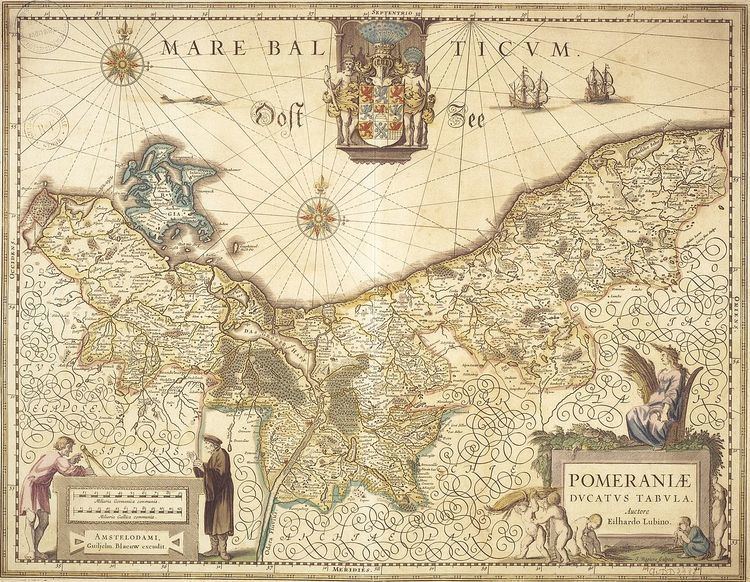 | ||
This is a list of the duchies and dukes of Pomerania.
Contents
- Dukes of the Slavic Pomeranian tribes All Pomerania
- Non dynastic
- Duchy of Pomerania
- First partition 1155 1264
- Second partition 1295 1368
- Third partition 1368 1376
- Fourth partition 13761377 1478
- Fifth partition 1531 1569
- Sixth partition 1569 1625
- Definitive reunification and annexation to Sweden
- Principality of Rugia
- Duchy of Pomerelia
- Partitions of the Duchy of Pomerelia
- Later history of Pomerelia
- References
Dukes of the Slavic Pomeranian tribes (All Pomerania)
The lands of Pomerania were firstly ruled by local tribes, who settled in Pomerania around the 10th and 11th centuries.
Non-dynastic
In 1106, Pomerania is divided by his two older sons: Wartislaw, who founded the House of Pomerania and the Duchy of Pomerania, and Świętopełk I. After Swietopelk's death, his lands were occupied by the Saxon prince Lothar of Supplinburg. In 1155, the lands regained independence under Sobieslaw I, who founded the dynasty of the Samborides, and the Duchy of Pomerelia.
Duchy of Pomerania
The Duchy resulted from the partition of Świętobor, Duke of Pomerania, in which his son Wartislaw inherited the lands that would become in fact known as Pomerania.
First partition 1155-1264
In 1155, Pomerania was divided in Pomerania-Stettin and Pomerania-Demmin. In 1190 the Land of Słupsk-Sławno separated itself from -Stettin.
In 1231 Emperor Frederick II granted the immediate liege lordship over Pomerania to the Margrave of Brandenburg, who enforced this claim by the Treaties of Kremmen (1236) and of Landin (1250). Thus Pomerania had become a fief of Brandenburg, thus an only mediate (indirect) subfief of the Empire, with Brandenburg itself being an immediate imperial fief.
Stettin Demmin Schlawe-Stolp
In 1227, Stolp came to Pomerelia, Schlawe to Pomerania. In 1238–1316 both became part of Pomerelia, ruled by an autonomously acting dynasty of castellans, the Swenzones (German: Swenzonen, entering history in 1257 with Swenzo the Elder). In 1316, the area became part of the Pomerania-Wolgast, first as a pawn from Brandenburg, and definitively in 1347.
After Wartislaw III died heirless in 1264, Barnim I became sole duke of the whole duchy. After Barnim's death, the duchy was to be ruled by his sons Barnim II, Otto I and Bogislaw IV. The first years, Bogislaw, being the eldest, ruled in place of his too young brothers.
Second partition 1295-1368
In 1295, the Duchy of Pomerania was divided roughly by the Peene and Ina (Ihna) rivers, with the areas north of these rivers ruled by Bogislaw IV became Pomerania-Wolgast, whereas Otto I received Pomerania-Szczecin south of these rivers.
Stettin Wolgast
Third partition 1368-1376
In 1368, Pomerania-Wolgast was divided into a western part (German: Wolgast diesseits der Swine, including the name-giving residence in Wolgast) and an eastern part (German: Wolgast jenseits der Swine, in literature also called Pomerania-Stolp after the residence in Stolp (Słupsk)).
Stettin Wolgast Wolgast-Stolp
Fourth partition 1376/1377-1478
In 1376, the western part of Pomerania-Wolgast (German: Wolgast diesseits der Swine) was subdivided in a smaller western part sometimes named Pomerania-Barth after the residence in Barth, and an eastern part which included the residence in Wolgast. In the following year, the eastern part of Pomerania-Wolgast (German: Wolgast diesseits der Swine or Pomerania-Stolp) was divided into a western part which included Stargard and an eastern part which included the residence in Stolp (Słupsk).
Stettin Wolgast Wolgast-Barth Wolgast-Stolp Wolgast-Stolp-Stargard
In 1459, the eastern partitions of Pomerania-Wolgast around Stargard and Stolp ceased to exist.
In 1478, after 200 years of partition, the duchy was reunited for a short period when all her parts were inherited by Bogislaw X.
Fifth partition 1531-1569
In 1531, Pomerania was partitioned into Pomerania-Stettin and Pomerania-Wolgast. This time however, in contrast to the earlier partitions with the same names, Pomerania-Wolgast included the western, and Pomerania-Stettin the eastern parts of the duchy.
Stettin Wolgast
Sixth partition 1569-1625
In 1569, were created the duchies of -Barth (split off from -Wolgast) and -Rügenwalde (Darłowo) (split off from -Stettin).
Stettin Wolgast Wolgast-Barth Rügenwalde
Definitive reunification and annexation to Sweden
In 1625, Bogislaw XIV reunited all Pomerania under his rule. However, in 1637, Sweden hold western parts of Pomerania (Hither Pomerania), originally including Stettin, legalised by the Peace of Westphalia in 1648 (Swedish Pomerania, several times reduced in favour of Brandenburgian Pomerania). Between 1637 and 1657 Lauenburg-Bütow Land came to Poland, thereafter to Brandenburg. In 1648, Brandenburg prevailed in the Peace of Westphalia with its claim only for eastern parts of Pomerania (Farther Pomerania), with the Brandenburg electors officially holding simultaneously the title of dukes of Pomerania until 1806 (end of the Empire and its enfeoffments), but de facto integrating their Pomerania into Brandenburg-Prussia, making it one of the provinces of Prussia in 1815, then including former Swedish Pomerania.
Principality of Rugia
1168–1325 feudal fief of Denmark under local rulers:
From 1325 Pomerania-Wolgast or -Barth:
from 1474 part of Pomerania-Wolgast
Duchy of Pomerelia
In 1155, the lands who belonged to Świętopełk I became independent under Sobieslaw I, a possible descendant, who founded the House of Sambor and the Duchy of Pomerelia.
The dukes of Pomerelia were using the Latin title dux Pomeraniae ("Duke of Pomerania") or dux Pomeranorum ("Duke of the Pomeranians").
Partitions of the Duchy of Pomerelia
In 1215, the duchy was divided in other smaller duchies: Gdańsk, Białogarda, Lubiszewo and Świecie.
Gdańsk Białogarda Lubiszewo Świecie
In 1271 the duchy is reunited and in 1296 annexed to the Kingdom of Poland
